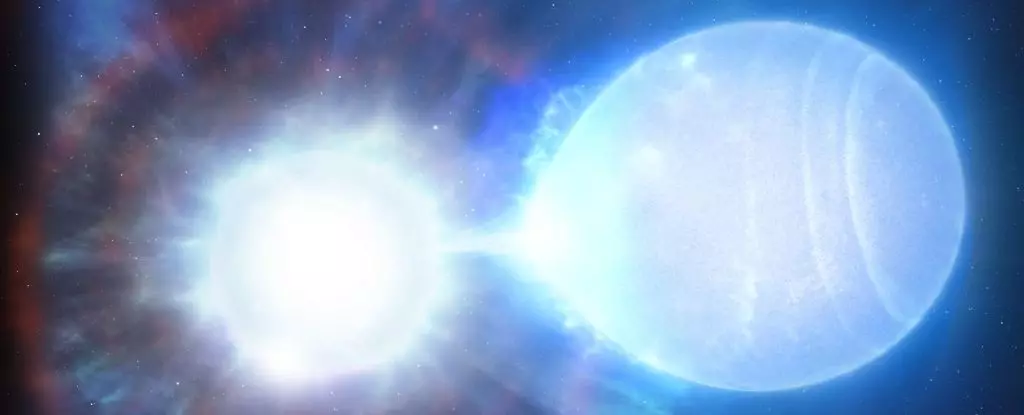In the vast expanse of space, the life cycle of celestial bodies narrates stories of birth, evolution, and eventual demise. Among these stars are the enigmatic white dwarfs—end states of stars that have exhausted their nuclear fuel. Their eventual fate has always intrigued astronomers: they drift towards a chilling conclusion, often leading to catastrophic events such as supernovae. New research has illuminated a binary system approximately 150 light-years from Earth, revealing that two white dwarfs are on a collision course that will culminate in a Type Ia supernova. This revelation not only superbly outlines the mechanics of stellar evolution but also bridges theoretical predictions with empirical evidence, painting a clearer picture of the universe’s intricate tapestry.
The Binary Stars: A Stellar Relationship
The two white dwarfs in question reside in a tightly bound binary system, which is crucial for their impending fate. Historically, it was hypothesized that such binaries could serve as progenitors for Type Ia supernovae, events that significantly contribute to the abundance of heavy elements in the universe. With a coherent understanding of supernova formation, this recent discovery affirms that scenarios beyond the traditional single white dwarf model can lead to these stellar explosions. Astrophysicist James Munday, who took part in this groundbreaking research, likened the newfound companion patterns to a shared dance between the two stars, where gravitational dynamics ultimately decide their tragic but foundational end.
A Long Time to Wait: The Cosmic Clock
While the imminent supernova explosion seems dramatic, it’s set to unfold an astonishing 23 billion years into the future. This timeline eclipses not only the current age of human civilization but also the estimated lifespan of our own Sun, which will transition to a white dwarf long before this event. In an age of rapid change and fleeting moments, contemplating such distant futures can evoke a sense of timelessness and insignificance, yet it also underscores the importance of understanding the cosmic mechanisms at play. The eventual collision and explosion will have repercussions far beyond our solar system, allowing future astronomers—if any exist—to glean insights into the nature of supernovae.
Mundane to Spectacular: Transforming Theoretical Calculations into Discoveries
Before this discovery, the existence of binary white dwarf systems as progenitors of Type Ia supernovae rested solely on theoretical grounds. Numerous models posited that the interaction between two closely orbiting white dwarfs could eventually lead one to siphon material from its companion, thus exceeding the Chandrasekhar limit—a specific mass threshold beyond which a white dwarf can no longer maintain its structural integrity. The significance of this discovery lies not only in confirming that such systems exist but also in providing a direct observational link to Type Ia supernovae. This boundary-blurring moment is akin to finding the missing piece of a complex puzzle, potentially giving rise to future discoveries as astronomers conduct extensive surveys to uncover similar systems across the Milky Way.
Implications Beyond the Cosmic Dance
The groundbreaking findings introduce a newfound appreciation for the prevalence of binary white dwarf systems, positing that many more are likely “hiding in plain sight.” Their existence may inform our understanding of cosmic distances, as Type Ia supernovae serve as critical benchmarks for astronomers charting the universe’s vastness. This dual discovery reaffirms the idea that the universe is rich in complexities; galaxies like our Milky Way host a multitude of celestial pairings, and the more we learn about them, the more we will uncover about fundamental astrophysical processes.
The Future of Stellar Studies: A Call for Exploration
Munday’s findings are a clarion call for continued exploration and investigation into binary white dwarf systems and their potential to illuminate the cosmic landscape. The combination of theoretical backing with observational evidence offers a holistic approach to studying supernovae and stellar evolution. This research sidelines the once murky waters of astrophysical predictions with a clear roadmap for identifying and studying future candidates for similar encounters. As astronomers refine their tools and techniques, they stand poised on the brink of further revolutionary discoveries.
In this ever-expanding universe, where knowledge is not just a quest but a shared voyage, the thrilling interplay of stars continues to captivate and inspire. Each revelation not only deepens our understanding of cosmic events but also invites us to look outward—and inward—at the very nature of existence, from stellar life cycles to human inquiry. Each white dwarf dance, destined to end in a dazzling explosion, reflects the combined beauty of cosmic phenomena and the relentless pursuit of truth in our quest to understand the universe.

